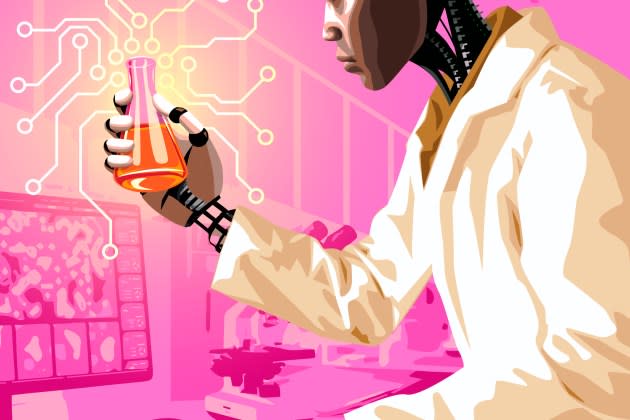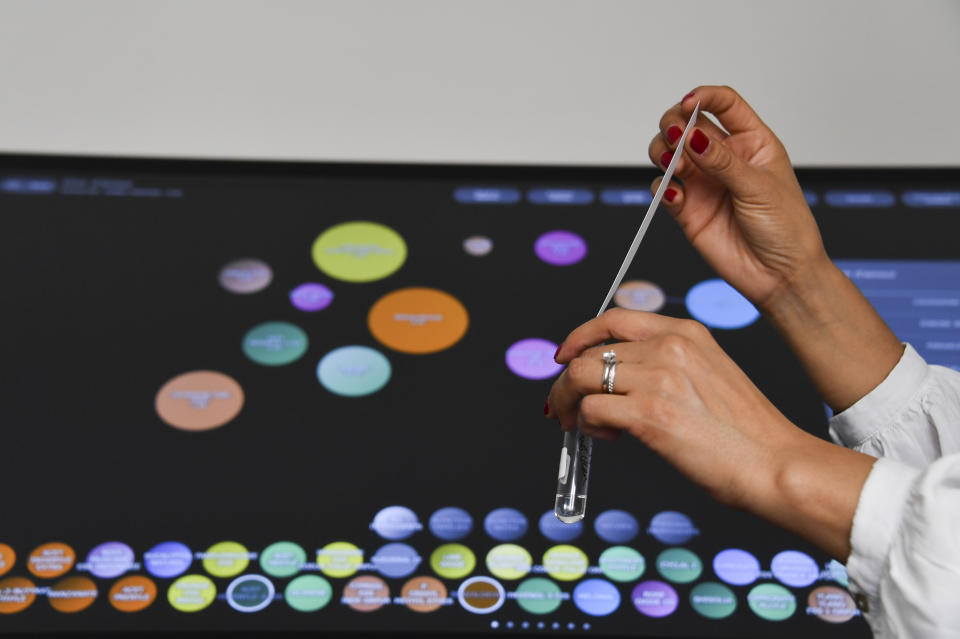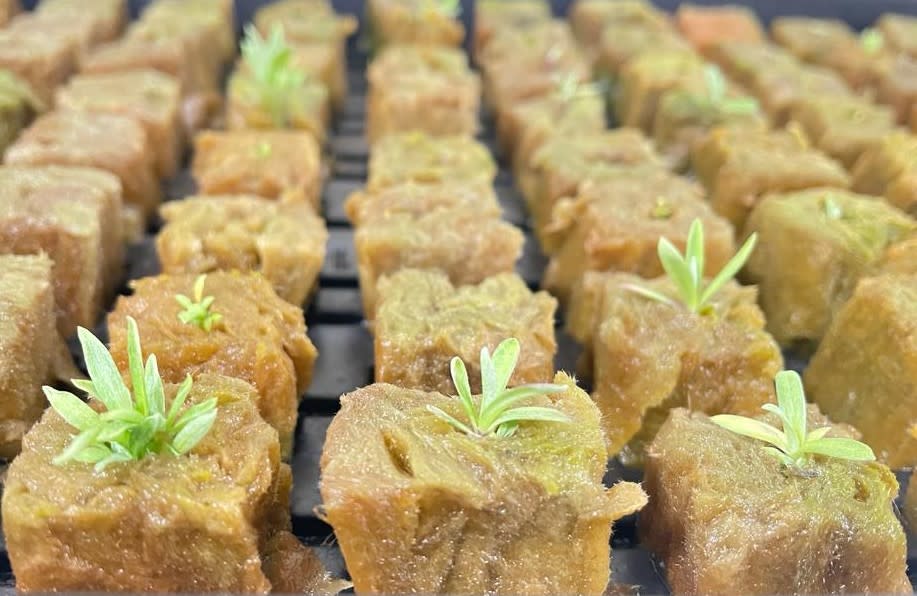AI Is Rewriting the Beauty Ingredient and Formula Creation Playbook

PARIS — Imagine, you want edelweiss in your skin care formulation. But it’s not any strain of that white-and-yellow flowered alpine plant you’re seeking. It is one with a very specific concentration of leontopondic acid and chlorogenic acid, giving strong anti-inflammatory and antiaging properties.
But edelweiss rarely grows in the wild anymore, and when it does, its nutrient concentrations are generally low.
More from WWD
The Next Generation of Beauty Filters Augment Content Value - Not Faces
Inside David Chung's Vertically Integrated Beauty Wonderland
Imagine, artificial intelligence mixed with precision farming could replicate the plant’s optimal harsh native environment — from the seeding to the surrounding soil and exposure to light, oxygen, water, UV and wind — to obtain the crop of your dreams.
That future is now.
Franco-Californian clean skin care brand Odacité has been using such an AI-driven technique.
In the edelweiss’ germination chamber, throughout its growth cycle, a camera and computer record minutia. When harvest takes place, plant extract is run through an AI-learning machine, whose output might suggest something as specific as one more minute of light for the next round of plants.
Seasons don’t exist anymore.
“We can harvest that edelweiss all year long at peak potency with an enhanced concentration of those two key assets,” said Valérie Grandury, founder and chief executive officer of Odacité, who launched Intense Repair Eye Cream with the ingredient. “If you look at very potent actives, this is the future of beauty. The possibilities are endless.”
Other beauty executives agree, as AI — and more recently Generative AI — seeps into product ingredient choice and formulation methods, it accelerates and amplifies innovation.
At L’Oréal, AI is being used to develop hair color shades. “This is for us a kind of magic interface,” said Caroline Goget, the group’s global head of hair color and texture development.
The process begins with identifying which hair hue L’Oréal wants to achieve. “It’s a color you can visualize, but we have to move from the physical world to the digital world first,” she said.

So a hue is created on a hair swatch, then the color is measured with a mathematical value that is a three-dimensional representation. The information is entered into an AI-digital assistant, which responds with four suggested dye combinations to get as close as possible to the color target.
“What we had to create with this predictive artificial intelligence is the connection between the dye combination and the color performance,” said Goget. “The challenge is the whole world of colors is huge. Therefore, there are millions, if not billions, of dye combinations that we can imagine. So how to create these two worlds communicating together? This is where data science is so important, because it is able to identify specific points at which we would create this connection.”
The easy-to-use technology hones in on the best solutions, and the scientists can give feedback to the AI-digital assistant to fine-tune its proposals.
“This assistant is able to suggest combinations that we never would have thought about,” said Goget. “This is the magic, because it opens the creativity of our teams and experts.”
It also accelerates work of the chemists, who ultimately decide which combination to choose and add their artistic flair to the color creation. This AI technology was created with scientific experts and keeps evolving.
L’Oréal’s in-house specialists develop made-to-measure AI tools for researchers, such as technology crafted to develop inclusive lipstick colors for the group’s upcoming lines.
Through social listening, L’Oréal found consumers have various challenges in selecting their lipstick shades vis-à-vis their own skin tone. The company learned, too, there are few universal lipstick colors available.

So L’Oréal conducted a study of 2,000 women, in France, China and India, who tried on 100 colors virtually via a patented algorithm created by color scientists. That analyzed information about the spectrum of bare and made-up lips culled from the women’s virtual renderings.
Within a few minutes, AI generated 100 lipstick colors for each woman. Altogether, that resulted in 200,000 images and an equal number of lipstick colors. Next, a predictive algorithm let L’Oréal process the data into color-space modeling for the design of inclusive color lines.
The Estée Lauder Cos. uses AI in a wide variety of ways, including predicting formula stability in a matter of days, a significant improvement over the six-month process without the technology. Leveraging in-vitro data, Lauder is further able to suss out the potential numeric level of an SPF.
Colekt has begun using AI in product creation. “AI can help us assess the environmental impact of various ingredients and production methods, for example,” said Roland-Philippe Kretzschmar, senior adviser at the Swedish clean beauty brand. “Based on that, we can then make more informed decisions on how to meet sustainability goals.”
This comes at a time when biosciences and biotechnology need to make big steps forward to help solve some of the world’s eco-challenges. AI can help Colekt keep abreast of ever-changing regulatory compliance. “And, of course, to be as innovative and agile as we can,” said brand founder Ellen af Petersens.
AI is also being deployed extensively for fragrance-making. Matteo Magnani, chief consumer and innovation officer of perfumery at DSM-Firmenich, believes the technology can have the most impact on ingredients and formulation in the scope of end-to-end perfume development.
“AI is an incredible tool to discover new molecules, to predict the properties of those molecules, replacing processes that can be lengthy and sometimes imperfect, like biodegradability assessment,” he said.
Evolving the olfactive ingredient palette is key, especially to fulfil mounting sustainability and safety compliance expectations, as well as create cost-optimization for customers. “The three things are connected, and ultimately it comes down to mass efficiency,” said Magnani. “For that, AI is a formidable tool.”
Take an example: In reformulating a fragrance to improve its carbon footprint, it is generally a complex job to analyze data, so the scent does not drift from its olfactive signature.
“If you can embed AI in the tools and the perfumers’ digital work stations, there’s an immediate gain in effectiveness of that process,” said Magnani. “It’s also great to push the boundaries in a new direction when it comes to consumer benefits that come with the fragrances. That’s where scientific knowledge behind the materials combined with the capability to manage and process that knowledge through AI can really add something.”
Another example: To create scents for well-being and emotional benefits, it’s necessary to tap into neuroscientific knowledge and drive models from there. AI helps develop and use such models.
“Say you’re working on a bar soap and you want to get a good bloom of the fragrance when you are about to wash your hands, and you have the right data on the chemical and physical properties of the material, you can build an AI-supported model that helps to optimize the formulation in that direction,” said Magnani.

Givaudan employs AI-powered technology, too. “It can give us a point of differentiation and value,” said Oriol Segui, head of fine fragrances Europe.
For social listening, a widely used technique, Givaudan engages its proprietary DigiPulse, billed to be the first olfactive listening tool created to collect and decode consumers’ online comments about fine fragrances, including their ingredients. “We can see the trends,” said Segui, though that information is not yet conveyed in real time.
Its proprietary Carto tool helps perfumers select raw materials they wish to mix and suggests the right dosage, after which a robot immediately whips up a sample. Data modeling can improve a product’s commercial appeal and finalize a fragrance. VAS Air technology helps perfumers understand which specific part of a fragrance consumers like best, to aid in modulating fragrance development.
“AI can really be helpful to push the boundaries of creation,” said Magnani.
“It’s a supporting tool,” said Kretzschmar.
“A compliment,” agreed af Petersens.
Over at LVMH Moët Hennessy Louis Vuitton’s beauty division, research and development executive vice president Bruno Bavouzet has been building a team of data scientists and AI capabilities to develop wide-reaching solutions. They have gathered in-real-life test results for different formulas.
“By applying all this data with algorithms and AI, we are able today to use some tools to predict the results of a formula without conducting the test,” he said. “This is not a 100 percent result when we do that, because you obviously have uncertainty. It’s a prediction based on the history and the past.”
Accuracy, however, is improving, while real tests need to be carried out at the end of the process. Today, AI can accelerate a product’s number of trials and speed to market, as well as increase innovation.
“Typically, to formulate a product, it could take a good three weeks to a month,” said David Chung, the founder of iLabs, referring to a first submission draft, not the finished formula. “AI could do the work in a couple of minutes. [Its power] is just mind-boggling.”
Back at LVMH, the group has vast information on skin typologies and consumers worldwide. “AI is a fantastic tool in order to bring some better insights and knowledge out of this data,” said Bavouzet. “We can discover new things and new relationships thanks to AI.”
That’s true for ingredient materials or combinations for cosmetics. “Thanks to AI, we really have systems today which are even smarter and cleverer in answering the questions you ask yourself,” said Bavouzet. That’s because the technology can treat even more data, synthesize it and give smart answers to researchers, helping to connect the dots like never before.”
Next-Gen Generative AI
For many in the industry, there’s a before and after Gen AI.
“If you go back to November of 2022,
when this whole Generative AI thing exploded, that’s really the pivot point — when suddenly machines understood what ‘like’ means,” said Mike Finley, cofounder, chief technology officer and chief scientist at AnswerRocket, a data intelligence company. “Before that, it was ‘if,’ ‘greater than,’ ‘less than,’ ‘more than’ and ‘divide by.’ Now, you can compare two things if the machine understands what they are. We can simply say to the machine: ‘If the molecule has these characteristics, therefore, it’s like these other molecules.’”
That’s been game-changing for beauty product makers. “Generative AI is going to be unlike any other previous evolutions of technology,” said Raheel Khan, senior vice president of foresight and growth intelligence at The Estée Lauder Cos., who also leads the group’s AI task force. “This one is going to be exponential in its impact.”

He added the technology “is going to enable us to further accelerate our strategy of merging math and magic. It works best when you have the right amount of high-volume data, plus folks who know how to ask the right questions.”
Lauder is well-placed to do that, with 50 years of proprietary data about ingredients, formulation, clinical testing and consumer understanding at a highly granular level. “Connecting all of this together, you can really unlock at scale customization and delivery to the consumer what they need with the power of AI and Generative AI,” said Khan.
Generative AI has an important role to play in biotechnology and fermentation of product ingredients; Lauder believes each step of product ingredient identification and formulation will either be enhanced significantly or replaced by a better process. Khan said AI and Generative AI play a role in elevating what’s done, but with human creativity and craftsmanship at the core.
“We believe still that the human remains at the center,” agreed Bavouzet. “At the end of the day, innovation comes from conviction, from being off the classical path. We still keep our people with their expertise, culture, sensitivity, identity at the core of the innovation process.”
Generative AI is also being taken extremely seriously at LVMH’s group level, as it is expected to drastically change work, according to Gonzague de Pirey, chief omnichannel and data officer. A company-wide coordinated strategy has been put in place, with a focused, responsible and ethical approach to Generative AI. LVMH has joined Stanford HAI to design and build human-centered AI to have positive human impacts. They audit LVMH’s use of algorithms.
The risks and challenges with Generative AI are manifold. On the legal side that might involve confidentiality, privacy and IP. Dispersion of technology in the broad ecosystem could create functional complexity. The technology comes with high cost as it requires expensive computers powerful enough for large-scale information crunching.
“The generative model is going to do what it’s good at — suggest more and more stuff. How do you vet that? The generative part is a benefit and a curse, because it won’t shut up,” said Finley.
“It’s an opportunity to be more creative, but it carries, as well, the risk of being less creative,” said de Piery. That’s because, by definition, Gen AI is about reducing volatility.
AI can’t yet offer a singular solution but can give categorical brute-force search.
Magnani and others are unsure that there will ever be a creative or imaginative AI.
“That’s what you need in perfumery to keep moving the industry forward,” he said. “You can’t do without the imagination and the creativity of a perfumer. And even more so, when you think of applying new knowledge and materials, it’s a constant evolution. So the past is not a good proxy for the future.”
Further beauty is in the eye of the beholder and also is contextual, leading to great nuances. “That’s still easier to interpret and translate for a human,” said Magnani.
Another sure fact is that AI is morphing
crazily fast. “Twenty-twenty-three was a year when people saw machines could do things that surprised them,” said Finley. “In 2024, we’re going to be surprised that it’s possible to do things that the machines do.”
Best of WWD

